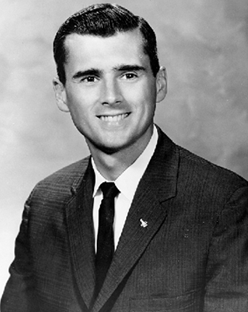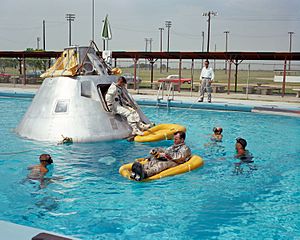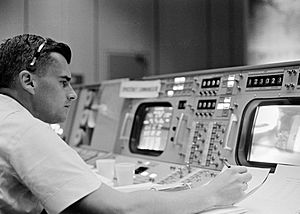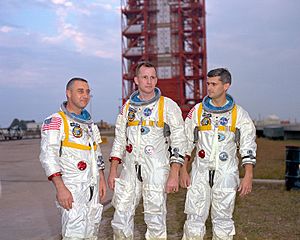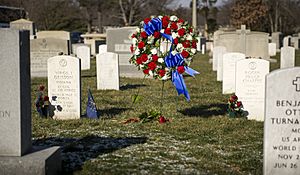Roger B. Chaffee facts for kids
Quick facts for kids
Roger B. Chaffee
|
|
|---|---|
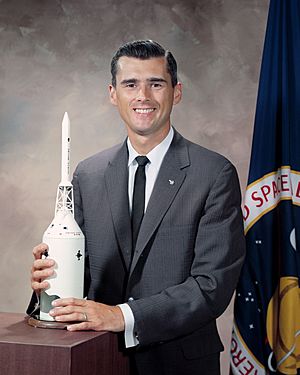
Chaffee in 1964
|
|
| Born |
Roger Bruce Chaffee
February 15, 1935 Grand Rapids, Michigan, U.S.
|
| Died | January 27, 1967 (aged 31) Cape Canaveral, Florida, U.S.
|
| Awards |
|
| Space career | |
| NASA astronaut | |
| Rank | Lieutenant commander, USN |
| Selection | NASA Group 3 (1963) |
| Missions | Apollo 1 |
|
Mission insignia
|
|
Roger Bruce Chaffee (born February 15, 1935 – died January 27, 1967) was an American Navy officer, pilot, and engineer. He became a NASA astronaut and was part of the Apollo program, which aimed to send humans to the Moon.
Chaffee was born in Grand Rapids, Michigan. He was a very active Eagle Scout in the Boy Scouts of America. After finishing Central High School in 1953, he received a scholarship to study at college. He first went to Illinois Institute of Technology and then transferred to Purdue University in 1954. At Purdue, he earned his private pilot's license.
In 1957, Chaffee graduated from Purdue with a degree in Aeronautical Engineering. He then joined the Navy as an ensign and started his pilot training. He flew different types of aircraft and became a quality and safety officer. During the Cuban Missile Crisis, he took important photos of Cuba, which earned him the Air Medal. He was promoted to lieutenant commander in 1966.
In 1963, NASA chose Chaffee and thirteen other pilots to become astronauts. He worked as a capsule communicator (CAPCOM) for the Gemini 3 and Gemini 4 missions. In 1966, he was chosen for his first space mission, Apollo 1. Sadly, in 1967, Roger Chaffee died in a fire during a test for the mission. This tragic accident happened with his fellow astronauts, Virgil "Gus" Grissom and Ed White, at Cape Kennedy Air Force Station. After his death, he was given the Congressional Space Medal of Honor and a second Air Medal.
Contents
Roger Chaffee's Early Life
Roger Bruce Chaffee was born on February 15, 1935, in Grand Rapids, Michigan. He was the second child of Donald and Blanche Chaffee. His father, who used to be a pilot, took Roger on his first flight when he was seven. This flight made Roger very excited about aviation. Soon after, he and his father started building model airplanes together.
Boy Scout Adventures
Roger was a very successful Boy Scout. He earned his first merit badge when he was thirteen. That year, he earned ten more badges, many of which were usually earned by older scouts. He continued to earn many badges and eventually became an Eagle Scout. He even earned extra awards called bronze and gold palms. Through his family camping trips and Boy Scout activities, Roger grew to love the outdoors.
School and College
Chaffee went to Dickinson School and then Central High School in Grand Rapids. He graduated in 1953, ranking among the top students in his class. He received a scholarship from the Naval Reserve Officers Training Corps (NROTC) and started college at the Illinois Institute of Technology in September 1953. He did very well in his studies.
Roger loved flying and was good at science and engineering. To use these skills, he moved to Purdue University in 1954. Purdue had a famous aeronautical engineering program. Before starting at Purdue, he spent eight weeks on the USS Wisconsin as part of the NROTC program. He visited England, Scotland, France, and Cuba during this tour.
While at Purdue, Chaffee worked different jobs to help pay for school. He also joined the Phi Kappa Sigma social club. He was chosen for important engineering honor societies like Tau Beta Pi and Sigma Gamma Tau. In 1955, he took some flying lessons but couldn't afford to get his full pilot's license. Two years later, the NROTC helped him get flight training to become a naval aviator. He flew alone for the first time on March 29, 1957, and got his private pilot's license on May 24, 1957. He earned his Bachelor of Science degree in aeronautical engineering from Purdue in 1957.
Family Life
Roger Chaffee met Martha Louise Horn in September 1955. They started dating, and he asked her to marry him in October 1956. They got married in Oklahoma City on August 24, 1957. Martha was a homemaker. Roger and Martha had two children: a daughter named Sheryl Lyn, born in 1958, and a son named Stephen, born in 1961.
After graduating from college, Chaffee finished his Navy training on August 22, 1957. He became an ensign. After his honeymoon, he was sent to the aircraft carrier USS Lake Champlain for six weeks. In October 1957, he began flight school at Naval Air Station Pensacola, Florida. He learned to fly planes like the T-28 and the T-34. He then trained on the F9F Cougar jet fighter. His daughter Sheryl was born just before he left for his first aircraft carrier training. He earned his naval aviator wings in early 1959.
Chaffee moved to Naval Air Station Jacksonville, Florida, for more training. One of his first tasks was to fix an A3D jet plane used for photo missions. He became so good at fixing it that he became one of the youngest pilots to fly it. He joined Attack Squadron 44 in September 1959.
There's only room for one mistake. You can buy the farm only once.
Over the next few years, Chaffee had many different assignments, mostly in photo reconnaissance squadrons. He worked as a safety and quality control officer for Heavy Photographic Squadron 62. He even wrote a manual to help improve quality control for his squadron. By chance, he was assigned a mission to fly over Cape Canaveral and take aerial photos of future rocket launch sites.
Between 1960 and 1962, during the important time of the Cuban Missile Crisis, Chaffee flew 82 missions over Cuba. Sometimes he flew up to three missions a day, logging over 100 flight hours each month. These flights included taking three people per plane to Guantanamo Bay. Some stories incorrectly say he flew the U-2 spy plane, but he was a Navy pilot, and the U-2 was an Air Force plane.
After this, Chaffee trained for aircraft carrier flights, including day and night landings on the USS Saratoga. He said landing a jet on a carrier was like "landing on a postage stamp." He also worked on his master's degree while stationed in Jacksonville. His son Stephen was born while Chaffee was on a cruise to Africa.
During his time in the Navy, Chaffee flew for more than 2,300 hours, with over 2,000 hours in jet aircraft. On February 1, 1966, he was promoted to lieutenant commander.
Roger Chaffee's NASA Career
Becoming an Astronaut
The world itself looks cleaner and so much more beautiful. Maybe we can make it that way—the way God intended it to be—by giving everybody that new perspective from out in space.
In August 1962, Chaffee told his family he had applied to the NASA astronaut training program. He also told his Navy bosses that he wanted to train as a test pilot to become an astronaut. In mid-1962, he was one of 1,800 people who applied for the third group of NASA astronauts. After his Navy tour, he had over 1,800 hours of flying time. The Navy offered him a chance to continue his master's degree. In January 1963, he started studying at the U.S. Air Force Institute of Technology (AFIT) in Dayton, Ohio, to earn his Master of Science degree in reliability engineering.
While at AFIT, Chaffee continued the astronaut tests. The number of candidates dropped to 271 in mid-1963. During testing, it was noted that he had a small lung capacity, but he used it very efficiently. On October 14, 1963, he found a message from NASA in Houston, Texas. He called them back and learned he had been chosen as an astronaut! On October 18, 1963, it was officially announced that he was one of fourteen people selected for NASA's third group of astronauts. He said he was "very pleased" and had always wanted to fly and do adventurous tasks.
Astronaut Training
The first part of training for the new astronauts began in 1964 with classroom lessons. They learned about many subjects and took trips to places with interesting geology. This was important because astronauts would need to do scientific experiments on the Moon. They visited the Grand Canyon to learn about geography and went to Alaska, Iceland, and Hawaii to study rocks and lava.
The second part of training was about survival. Astronauts learned how to survive if their spacecraft landed somewhere unexpected. They were dropped in the jungle in Panama with only their parachutes and survival kits. Chaffee, using his Boy Scout skills, found enough food to survive for three days. After the jungle, they went to the desert in Reno, Nevada. They had only long underwear, shoes, and robes made from their parachutes. They ate lizards and snakes and used their parachutes as tents for two days.
The third and final part of training was hands-on practice. This focused on using the tools and equipment needed for spaceflight. They trained to understand the effects of microgravity (weightlessness) and fast acceleration. Astronauts spent time in simulators, flew in cargo planes that created weightlessness, and practiced spacewalks underwater. They also visited factories to check on the spacecraft parts being built.
Project Gemini Missions
Each astronaut had a special area of focus. Chaffee's specialty was communications. He worked on the Deep Space Instrumentation Facility (DSIF), which was important for astronauts to navigate in space.
At the Manned Spacecraft Center in Houston, Chaffee worked as a capsule communicator (CAPCOM) in March 1965 for Gemini 3. Later that year, he was also a CAPCOM for the Gemini 4 mission. During Gemini 4, Ed White performed the first spacewalk by an American. As CAPCOM, Chaffee was the main person who talked between the astronauts in space and the flight director, Chris Kraft, on Earth. He never flew on a Gemini mission himself, but he helped with flight control, communications, and other systems for the Apollo program. He also flew chase planes to film the launch of uncrewed Saturn 1B rockets.
Apollo Program and Apollo 1
Roger Chaffee received his first spaceflight assignment in January 1966. He was chosen for the first crewed Apollo-Saturn flight, called AS-204. At that time, he was the youngest American astronaut picked for a mission. He joined Command Pilot Grissom and Senior Pilot White. He took the place of Donn F. Eisele, who had to have surgery for a shoulder injury.
The crew for Apollo 1 was announced on March 21, 1966. The two-week flight of Apollo 1 was planned to test the spacecraft's systems and the ground control facilities. Chaffee had watched the Gemini spacecraft being built, but not the Apollo spacecraft. Three days after being chosen for the Apollo 1 crew, he flew to the North American Aviation factory in Downey, California, to see it.
Later in April, the crew went to Chapel Hill, North Carolina, to study stars that were programmed into their flight computer. In October, the six crew members planned to test the spacecraft in sea level and high-altitude conditions. They couldn't do the vacuum test because of a problem with an oxygen regulator, but they completed the sea level test. They also practiced exiting the spacecraft after it landed in the Gulf of Mexico. The crew spent Christmas with their families. Chaffee even won first prize in a local Christmas decoration contest. Four Purdue astronauts, including Grissom, Gene Cernan, Neil Armstrong, and Chaffee, attended the Rose Bowl game on January 2, 1967. NASA announced on January 23 that February 21 was the target launch date for Apollo 1. The main and backup crews moved back to Cape Kennedy for the final weeks of training.
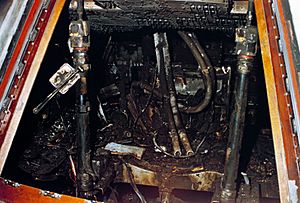
On Friday, January 27, 1967, Grissom, White, and Chaffee were doing a "plugs-out" test at Cape Kennedy. This was a practice countdown for the launch. Chaffee was sitting on the right side of the cabin. His main job was to talk with the control room. A brief power surge was seen at 6:30 pm EST. This was thought to be an electrical short that started a fire on the lower left side of the cabin. At 6:31:04 pm EST, a voice was heard saying, "We've got a fire in the cockpit." Most people believe this was Chaffee's voice.
The astronauts had emergency roles. Grissom was supposed to open a valve to release cabin pressure, then White was to open the hatch, while Chaffee kept talking to control. The fire was too intense for Grissom to open the valve. White tried to open the hatch, but the pressure inside the cabin held it shut. The increasing pressure finally broke the inner cabin wall. The fire, fueled by pure oxygen, burned intensely for about thirty seconds. Then, as outside air entered, the main fire lessened, but it produced a lot of smoke. This smoke caused the astronauts to lose consciousness. Chaffee died from not having enough oxygen and breathing toxic gases from the fire. Burns also contributed to his death.
Firefighters eventually opened the hatch, and by then the fire had gone out. Chaffee's seat was found in a horizontal position. His helmet was closed, and his restraints were undone. He was farthest from where the fire started, so he had the least burn and suit damage.
After the Accident
After the Apollo 1 fire in 1967, NASA decided to officially call the mission Apollo 1. The spacecraft was greatly redesigned because of the disaster. The air inside the cabin was changed from 100% oxygen to a mix of 60% oxygen and 40% nitrogen for launch. The astronauts' spacesuits, which were originally made of nylon, were changed to beta cloth. This new fabric was non-flammable and very resistant to melting. Other changes included replacing flammable materials inside the cabin with fire-resistant ones and covering wires with protective insulation.
Chaffee and Grissom were buried in Arlington National Cemetery. White was buried at West Point Cemetery. Chaffee's wife received money from the life insurance part of a contract the astronauts had with publishing companies.
Remembering Roger Chaffee
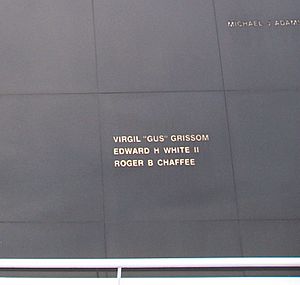
Roger Chaffee is remembered in many ways. There is a Chaffee Crater on the far side of the Moon. The Roger B. Chaffee Planetarium in his hometown of Grand Rapids, Michigan, is named after him. When the Kent County International Airport moved in 1963, the main runway of the old airport became a road named Roger B. Chaffee Boulevard.
There is also a hill on Mars called Chaffee Hill, which is part of the Apollo 1 Hills. Regor (which is Roger spelled backwards) is a nickname for the star Gamma Velorum. Grissom used this name, along with names for White and himself, on his Apollo 1 star charts as a joke. Later Apollo astronauts kept using these names to remember them.
A man-made island off Long Beach, California, created in 1966 for drilling oil, is named Chaffee Island. Parks in Fullerton, California, were also named after Chaffee and his Apollo 1 crewmates. Chaffee's name is on the Space Mirror Memorial, which was dedicated in 1991. His name is also on a plaque left on the Moon with the Fallen Astronaut statue in 1971 by the crew of Apollo 15.
The dismantled Launch Pad 34 at Cape Canaveral has two plaques to remember the Apollo 1 crew:
They gave their lives in service to their country in the ongoing exploration of humankind's final frontier. Remember them not for how they died but for those ideals for which they lived.
In memory of those who made the ultimate sacrifice so others could reach for the stars. Ad astra per aspera (a rough road leads to the stars). God speed to the crew of Apollo 1.
The Roger B. Chaffee scholarship has been given every year since 1967 to excellent high school students in the Kent Intermediate School District who want to work in math and science. Chaffee Hall, an engineering building at his college, Purdue University, was named after him in 1968. Grissom High School, Ed White Middle School, and Chaffee Elementary School in Huntsville, Alabama, are also named after the Apollo 1 astronauts.
"Roger That!" is an event held every year by the Grand Rapids Public Museum and Grand Valley State University. It celebrates space exploration and the life of Chaffee, who was from Grand Rapids.
Awards and Special Honors
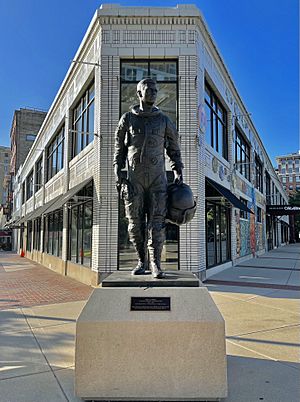
Roger Chaffee received the Navy Air Medal for his work in Heavy Photographic Squadron 62. He completed 82 secret missions that were very important for the safety of the United States. The Apollo 1 crew was given the NASA Distinguished Service Medal after their deaths in 1969. He was also given a second Air Medal after his death.
He was added to the International Space Hall of Fame in 1983 and the U.S. Astronaut Hall of Fame on October 4, 1997. Chaffee and White were given the Congressional Space Medal of Honor after their deaths in 1997. (Grissom received his medal in 1978). In 2007, Chaffee was also given the NASA Ambassador of Exploration Award for his part in the U.S. space program.
On the TV show Star Trek: Deep Space Nine, a fictional spacecraft from the 24th century was named after him. It was designed by Doug Drexler. They named it after Chaffee to remind people about the dangers of space exploration. Star Trek and NASA have worked together for a long time, starting in the late 1960s when the show first aired.
In 2018, a life-size bronze statue of Chaffee was revealed outside the Grand Rapids Children's Museum in his hometown. His wife, other family members, and astronaut Jack Lousma were there for the event.
See also
 In Spanish: Roger Chaffee para niños
In Spanish: Roger Chaffee para niños
- Fallen Astronaut
- List of Eagle Scouts
- The Astronaut Monument
- List of spaceflight-related accidents and incidents


